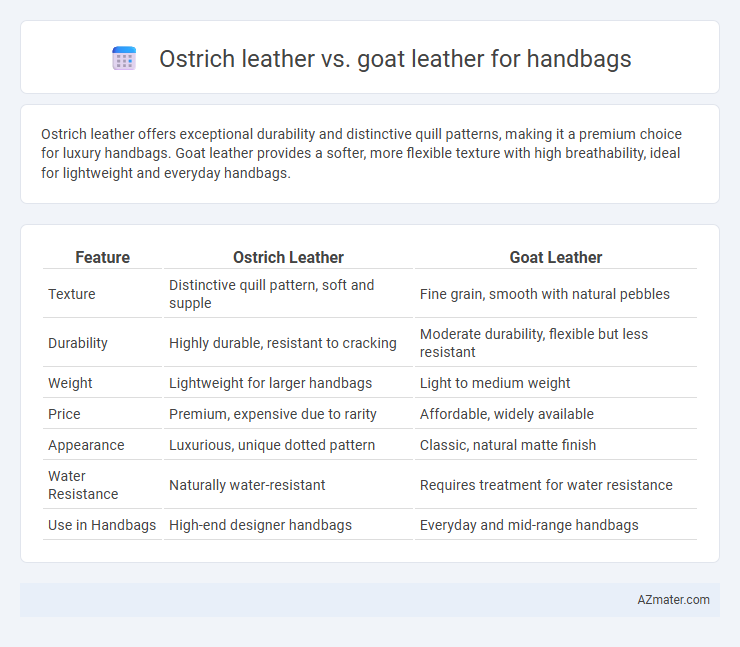Ostrich leather offers exceptional durability and distinctive quill patterns, making it a premium choice for luxury handbags. Goat leather provides a softer, more flexible texture with high breathability, ideal for lightweight and everyday handbags.
Table of Comparison
| Feature | Ostrich Leather | Goat Leather |
|---|---|---|
| Texture | Distinctive quill pattern, soft and supple | Fine grain, smooth with natural pebbles |
| Durability | Highly durable, resistant to cracking | Moderate durability, flexible but less resistant |
| Weight | Lightweight for larger handbags | Light to medium weight |
| Price | Premium, expensive due to rarity | Affordable, widely available |
| Appearance | Luxurious, unique dotted pattern | Classic, natural matte finish |
| Water Resistance | Naturally water-resistant | Requires treatment for water resistance |
| Use in Handbags | High-end designer handbags | Everyday and mid-range handbags |
Introduction to Exotic Leathers: Ostrich vs Goat
Ostrich leather is renowned for its distinctive quill follicle pattern, offering a luxurious texture and exceptional durability ideal for high-end handbags. Goat leather, characterized by its supple feel and fine grain, provides a lightweight yet strong option commonly used for everyday handbags with a natural elegance. Both leathers are prized in exotic leather markets, with ostrich standing out for its unique appearance and longevity, while goat leather is favored for flexibility and affordability.
Key Differences in Texture and Appearance
Ostrich leather features a distinctive quill pattern with raised bumps, offering a unique, luxurious texture that is both soft and durable, making it highly sought after for high-end handbags. In contrast, goat leather has a smoother, more uniform grain with a supple feel and a matte finish, lending itself to more casual and versatile handbag designs. The visual appeal of ostrich leather is bold and exotic, while goat leather provides a classic, understated elegance with greater flexibility in color treatments.
Durability and Longevity Comparison
Ostrich leather is renowned for its exceptional durability due to its unique quill follicle pattern and natural oils, which offer resistance to cracking and wear, making it ideal for long-lasting handbags. Goat leather, while also durable, tends to be more flexible and softer but may show signs of aging and wear faster under heavy use compared to ostrich leather. When prioritizing longevity, ostrich leather generally outperforms goat leather by maintaining its structural integrity and appearance over extended periods.
Weight and Handbag Comfort
Ostrich leather is heavier yet offers a distinctive, durable texture that enhances the structural integrity of handbags, making them more rigid but potentially less comfortable for prolonged wear. Goat leather is lighter and more supple, providing enhanced comfort and flexibility, ideal for everyday handbags that prioritize ease of handling. Choosing between ostrich and goat leather hinges on the balance between desired handbag weight and wearer comfort.
Water Resistance and Maintenance
Ostrich leather offers superior water resistance compared to goat leather due to its natural oils and dense quill follicles, making it less prone to water damage and staining. Goat leather, while durable and more affordable, absorbs moisture more readily and requires more frequent conditioning and waterproof treatments to maintain its appearance and longevity. For handbags, ostrich leather demands less maintenance and provides enhanced protection in wet conditions, ideal for users seeking both luxury and practicality.
Cost Analysis: Ostrich vs Goat Leather
Ostrich leather commands a significantly higher price than goat leather due to its rarity, distinctive quill follicle pattern, and durability, making it a luxury option for handbags. Goat leather is more cost-effective, widely available, and offers good strength and softness, resulting in affordable handbags with reliable quality. Investment in ostrich leather handbags typically yields longer-lasting products with unique aesthetics, while goat leather provides budget-friendly alternatives without compromising basic durability and style.
Eco-Friendliness and Ethical Sourcing
Ostrich leather stands out for its durability and distinctive texture, sourced mainly from farmed birds, which can align with sustainable practices when farms prioritize animal welfare and habitat conservation. Goat leather, often a byproduct of the meat industry, is generally considered more eco-friendly due to its lower environmental impact, quicker biodegradable properties, and the use of small-scale, traditional tanning methods. Ethical sourcing of both types depends heavily on certifications like the Leather Working Group and adherence to cruelty-free standards, making transparent supply chains crucial for eco-conscious handbag consumers.
Popular Uses in Luxury Handbags
Ostrich leather is prized in luxury handbags for its distinctive quill pattern, offering a unique texture and high durability that appeals to premium fashion brands. Goat leather, known for its softness and fine grain, is favored for versatile, lightweight handbags that combine elegance with resilience. Both leathers are extensively used by designer labels, with ostrich leather often reserved for statement pieces and goat leather for everyday sophisticated styles.
Style Versatility and Design Options
Ostrich leather offers a unique, luxurious texture characterized by its distinctive quill pattern, adding an exotic appeal to handbags that aligns with high-end fashion and statement pieces. Goat leather provides greater style versatility due to its softer, more pliable nature and smooth grain, making it suitable for a wide range of handbag designs from casual to formal. Design options in ostrich leather are often limited by its characteristic pattern, whereas goat leather allows for diverse finishes, embossing, and dyeing, accommodating varied aesthetic preferences and trends.
Choosing the Best Leather for Your Handbag
Ostrich leather offers exceptional durability and a unique, textured pattern with raised quill follicles, making it highly sought after for luxury handbags, while goat leather provides a softer, more supple feel with a fine grain and excellent flexibility. For a handbag that combines strength and distinctive aesthetics, ostrich leather is ideal due to its resistance to wear and aging, whereas goat leather suits those prioritizing lightweight comfort and ease of maintenance. Assess factors like desired texture, durability, and budget to choose the best leather that aligns with your handbag's style and functionality.

Infographic: Ostrich leather vs Goat leather for Handbag
 azmater.com
azmater.com